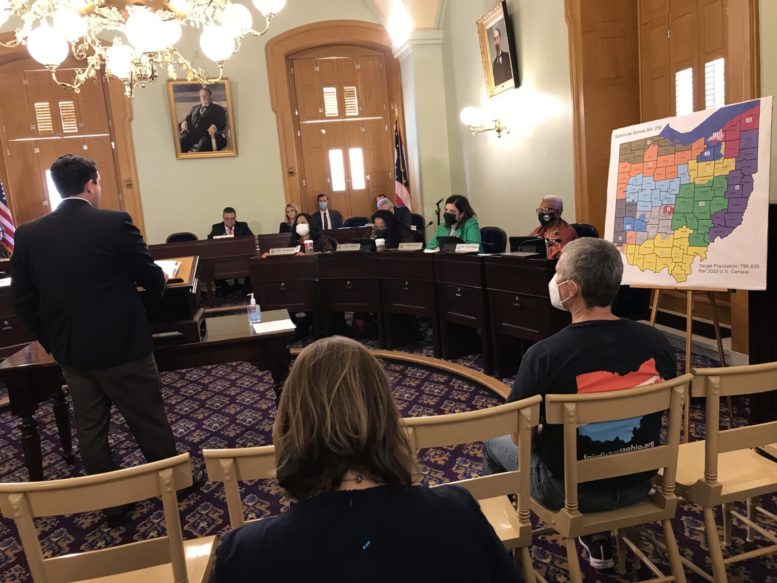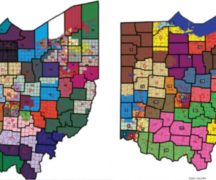BY SUSAN TEBBEN
The Ohio House is set to vote on congressional redistricting maps on Thursday, after a House committee passed the Senate GOP maps 8-5 along partisan lines in a Wednesday hearing.
The House Government Oversight Committee heard from state Sen. Rob McColley on Senate Bill 258, the congressional redistricting maps passed by the Senate the day before.

The map has seven Republican districts, two Democratic districts and six districts considered competitive under a 54-46 margin.
No public testimony was heard on Wednesday, but McColley fielded several questions from committee members who asked about the authors of the maps, the decision-making in splits to areas such as Cuyahoga and Hamilton counties, and how public input played into the new map.
“The constitution, in our reading, and I think it’s pretty clear, allows us to split up to five counties twice,” McColley said in response to state Rep. Brigid Kelly’s question as to why Hamilton County was split.
McColley said the population of Hamilton County, and the population of other counties larger than the target population of just over 780,000 in each district, led to the need for more splits.
Committee Democrats attempted to introduce an amendment, but the chair, state Rep. Shane Wilkins, said the amendment was out of order since no amendments were scheduled to happen during the meeting.
State Rep. Richard Brown said Democrats presented the amendment because the Nov. 30 deadline for approval of maps by the General Assembly is still two weeks away, allowing time for more conversations.
“The Democratic Caucus believes there should be a discussion of these maps and these issues, there really hasn’t been any discussion or compromise with Republicans on this issue,” Brown said.
Brown said Democrats are still aiming for a 10-year map, and McColley said it was always his goal to get a 10-year map, however he acknowledged his proposal “didn’t have the votes” to reach bipartisan support. For that reason, if the House approves the proposed map along party lines, it will only be effect for four years.
The House is expected to take up the issue at their session starting at 1 p.m. on Thursday.
***
Also from Ohio Capital Journal:
Armed teachers bill passes Ohio House; Proposed law now moves over to Senate
Some teachers-turned-legislators urged their colleagues to vote against a bill to authorize school boards to allow teachers and other school personnel to come armed to school.
House Bill 99 would create a minimum amount of training, 20 hours initially and four hours on a recurring basis, for educators to bring guns to school. The bill passed out of the House on a 58-33 vote, with the only GOP “no” vote coming from former elementary school teacher and state Rep. Gayle Manning, R-North Ridgeville. (State Rep. Haraz Ghanbari, R-Perrysburg, voted in favor.)
Bill sponsor Thomas Hall, R-Madison Twp., said the bill is especially necessary for rural areas where first responders aren’t as populous and can take longer to get to schools in the event of an emergency.
“Some of the inner city schools have police officers at their school, some of these rural schools don’t have that luxury,” Hall said.
State Rep. Stephanie Howse, D-Cleveland, took issue with the idea that the bill would be universally welcomed in schools, particularly in predominantly Black schools, as well as those that have to pass through metal detectors just to get into schools.
“Ask our Black boys … how safe will they feel knowing that they have armed teachers,” Howse said. “When you look statistically, our children, Black babies, are overcriminalized.” READ MORE
‘Money without oversight;’ lawmaker proposes giving nursing homes $300 million
State lawmakers are considering giving Ohio’s nursing homes $300 million in federal funds to recover from the pandemic with no requirements regarding caregiver pay or quality of care.
The lump sum payment in House Bill 461 would come with no requirements that the funds go to raise notoriously low salaries of the caregiver workforce or avoid homes with histories of infection control violations. Ohio, through Medicaid, spent $6.4 billion on long term care in fiscal year 2020, according to data from the Kaiser Family Foundation.
House Rep. Sara Carruthers, R-Hamilton, said occupancy rates are lower and staffing and care costs are higher in long term care facilities, a direct biproduct of the COVID-19 pandemic.
Speaking to the House Economic Development and Workforce Committee, she indicated she’d be willing to submit an amendment forbidding nursing homes that accept the funds from “discriminating” against unvaccinated employees.
In Ohio, at least 8,407 nursing home residents died of COVID-19, according to state data. During the pandemic, the Centers for Medicare and Medicaid Services cited 897 Ohio nursing homes with infection control violations, according to documents obtained via public records requests. Several dozen yielded findings of “immediate jeopardy,” the most severe violations. READ MORE





